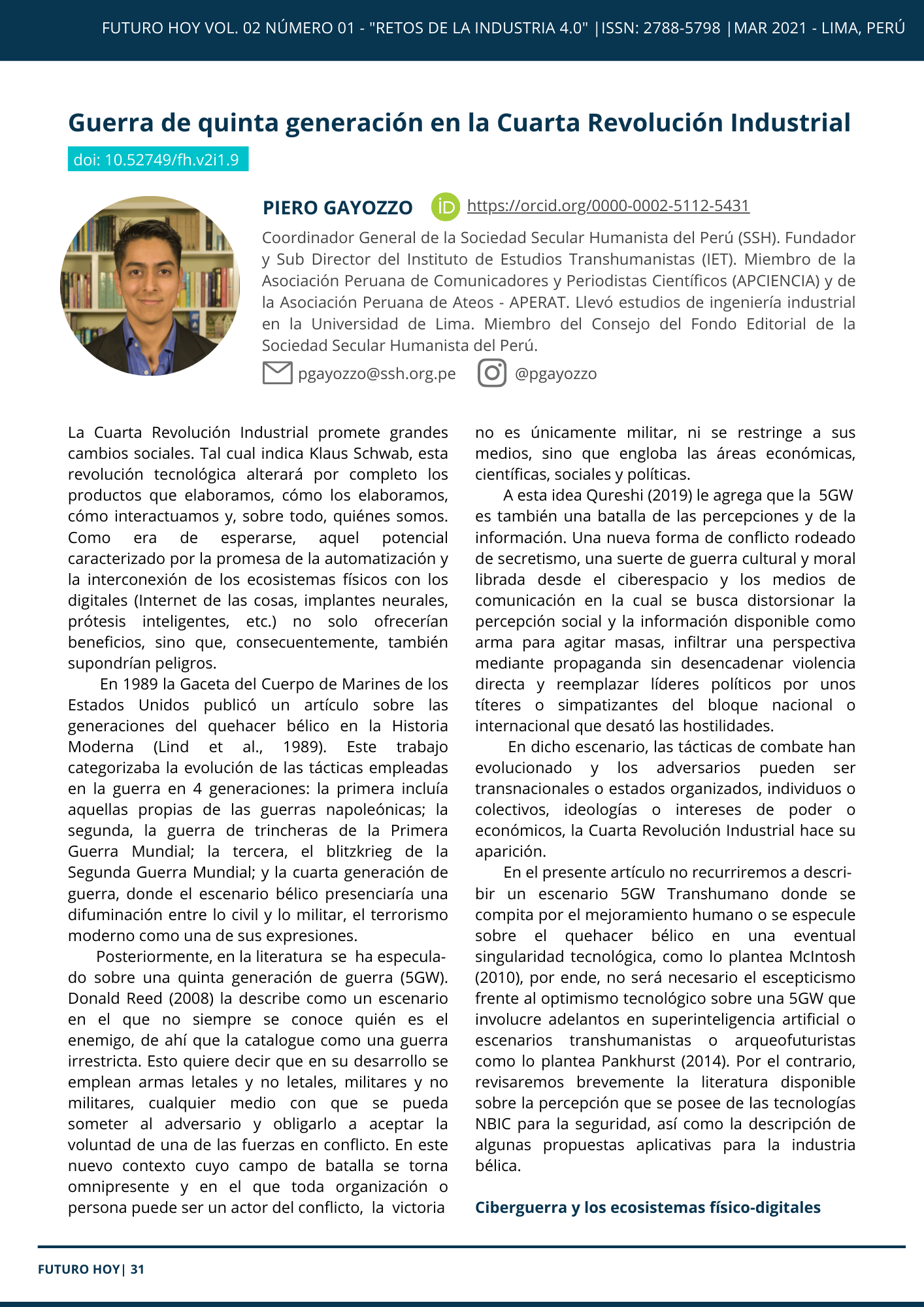Guerra de quinta generación en la Cuarta Revolución Industrial
DOI:
https://doi.org/10.52749/fh.v2i1.9Palabras clave:
Cuarta Revolución Industrial, Guerra, Nanomateriales, Deep Fakes, BioterrorismoResumen
La Cuarta Revolución Industrial promete cambiar drásticamente toda interacción social incluido el quehacer bélico. El propósito del siguiente ar´tículo es el de explorar cuál sería la forma y cuáles serían los alcances de la guerra en la Cuarta Revolución Industrial. Para ello se revisó la literatura concerniente a la descripción de las generaciones del quehacer bélico a lo largo de la modernidad. Luego se analizaron algunos posibles escenarios de peligro ocasionados por tecnologías actualmente existentes como las tecnologías de la información, las biotecnologías y las nanotecnologías. El estudio concluyó que sin necesidad de recurrir a un futuro transhumano, es posible discutir sobre una quinta generación del quehacer bélico que se caracterice por ser difusa, bioterrorista, desestabilizadora, auto-generada, manipuladora y ubicua.
Descargas
Citas
Balkan, S. (2017). Daesh's Drone Strategy. Technology and the rise of innovative terrorism. SETA.
Bunge, M. (2013). Filosofía Política. Solidaridad, cooperación y Democracia Integral. Gedisa.
Coenen, C. (2017). Biohacking: New Do-It-Yourself Practices as Technoscientific Work between Freedom and Necessity.
Multidisciplinary Digital Publishing Institute Proceedings, 1(3), 256. https://doi.org/10.3390/IS4SI-2017-04119
Czosseck, C., Ottis, R., & Talihärm, A. M. (2011). Estonia after the 2007 Cyber Attacks: Legal, Strategic and Organisational Changes in Cyber Security. International Journal of Cyber Warfare and Terrorism, 1(1), 24-34. https://doi.org/10.4018/ijcwt.2011010103
Lacinák, M., & Ristvej, J. (2017). Smart City, Safety and Security. Procedia Engineering, 192, 522-527. https://doi.org/10.1016/j.proeng.2017.06.090
Lind, W. S., Nightengale, K., Schmitt, J., Sutton, J. W., & Wilson, I. (1989). The Changing Face of War: Into the Fourth
Generation. En A. Karp, R. Karp, & T. Terrif (eds.), Global Insurgency and the Future of armed conflict (p. 8). Routledge. https://doi.org/10.4324/9780203089279
Marín, J. A. (29 de Enero de 2018). El uso de drones comerciales como vectores terroristas. Instituto Español de Estudios Estratégicos.
McIntosh, D. (2010). Transhuman Politics and Fifth Generation War. Nimble Books.
Molist, M. (21 de enero de 2016). Así es como un ciberataque deja toda una ciudad a oscuras. El confidencial. https://www.elconfidencial.com/tecnologia/2016-01-21/amenazas-en-la-oscuridad-como-los-hackers-puedenprovocar-un-apagon-en-tu-ciudad_1138837/
Ottis, R. (2008). Analysis of the 2007 Cyber Attacks Against Estonia from the Information Warfare Perspective. https://ccdcoe.org/uploads/2018/10/Ottis2008_AnalysisOf2007FromTheInformationWarfarePerspective.pdf
Pankhurst, C. (23 de Mayo de 2014). Posthuman prospects: Artificial Intelligence, Fifth Generation Warfare & Archeofuturism.
Qureshi, W. A. (2019). Fourth and Fifth Generation Warfare: Technology and Perceptions. San Diego International Law Journal, 21(1), 187-216. https://digital.sandiego.edu/ilj/vol21/iss1/7/
Reed, D. J. (2008). Beyond the War on Terror: Into the Fifth Generation of War and Conflict. Studies in Conflict & Terrorism, 31(8), 684-722.
https://doi.org/10.1080/10576100802206533
Regalado, A. (9 de Febrero de 2016). Top U.S. Intelligence Official calls gene editing a WMD threat. MIT Technology Review.
Schreier, F. (2015). On Cyberwarfare. DCAF Horizon. https://www.dcaf.ch/sites/default/files/publications/documents/OnCyberwarfare-Schreier.pdf
Sharon, M., Silvestre, A., Rodriguez, L., Sharon, C., & Sifuentes, P. (2019). Nanotechnology in the Defense Industry. Scrivener
Publishing.
Stenersen, A. (2013). ‘Bomb-Making for Beginners’: Inside al AlQaeda E-Learning Course. Perspectives on Terrorism, 25-37.
http://www.jstor.com/stable/26296907
Westerlund, M. (2019). The Emergence of Deepfake Technology: A Review. Technology Innovation Management Review, 9(11),
-52. https://doi.org/10.22215/timreview/1282
Wikswo, J., Hummel, S., & Quaranta, V. (2014). The Biohacker: A Threat to National Security. Combating Terrorist Center
Sentinel, 7(1), 8-11. https://ctc.usma.edu/the-biohacker-athreat-to-national-security/
Wolinsky, H. (2016). The FBI and biohackers: an unusual relationship. EMBO Reports, 793-796.

Descargas
Publicado
Cómo citar
Número
Sección
Licencia
Derechos de autor 2021 Piero Gayozzo

Esta obra está bajo una licencia internacional Creative Commons Atribución 4.0.
El autor de cada artículo o contribución académica publicada en Futuro Hoy se compromete a otorgar derechos de uso a otros gracias al registro en Creative Commons BY 4.0 que la Editorial ha tramitado para su obra. Esto permite el acceso gratuito e inmediato a la obra y permite a cualquier usuario leer, descargar, copiar, distribuir, imprimir, buscar o vincular acceder a los textos completos de los artículos, rastrearlos para indexarlos, pasarlos como datos al software o utilizarlos para cualquier otro propósito legal. Cada autor mantiene los derechos de su obra. La revista Futuro Hoy posee los derechos de publicación de cada artículo. La revista no se responsabiliza por los comentarios vertidos por cada autor.



